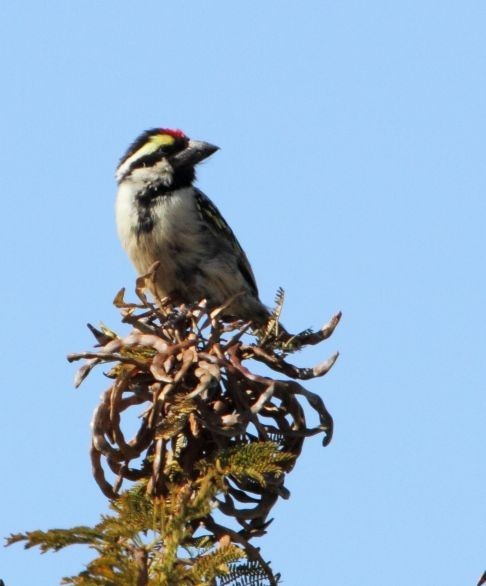Acacia Pied Barbet
A species of Pied Barbets and Allies Scientific name : Tricholaema leucomelas Genus : Pied Barbets and Allies
Acacia Pied Barbet, A species of Pied Barbets and Allies
Botanical name: Tricholaema leucomelas
Genus: Pied Barbets and Allies
Content
Description General Info
 Photo By Alandmanson , used under CC-BY-SA-4.0 /Cropped and compressed from original
Photo By Alandmanson , used under CC-BY-SA-4.0 /Cropped and compressed from original Description
The acacia pied barbet has a black-and-white striped head with a red forehead and yellow colouring above the eyes. It has a black bib under the chin, with a white breast and underparts. 
Size
17 cm
Nest Placement
Cavity
Feeding Habits
Acacia Pied Barbet consumes a diverse omnivorous diet, including lantana fruits, Salvadora persica, Sophora seeds, nectar, and insects like grasshoppers and beetles. Acacia Pied Barbet displays varied foraging behaviors at different bush and tree levels, adeptly clinging or hanging to access fruits.
Habitat
Acacia Pied Barbet thrives in semi-arid savanna ecosystems and is particularly adapted to Acacia and Baikiaea woodlands, as well as streamside forests and scrublands. They inhabit areas from grasslands and fynbos to agricultural and urban gardens. Comfortable in a range of altitudes up to 1500 meters, they predominantly occupy regions above 400 meters, and can adapt to desert regions with suitable nesting trees.
Dite type
Insectivorous
General Info
Feeding Habits
Bird food type
Behavior
Like most other barbets, the acacia pied barbet drills holes into dead wood to create cavity nests, like a woodpecker. It lays two to four eggs from August to April, and both sexes incubate the eggs. The acacia pied barbet has been observed taking fruit from various trees and shrubs, such as Ficus, Rhus and Phoenix reclinata, as well as Aloe nectar and insects. 
Distribution Area
It primarily inhabits semi-arid savanna, as well as grassland, fynbos, agricultural areas and urban gardens, where it did not inhabit previously. With the introduction of alien vegetation, especially Acacia species from Australia, to regions bordering its original range, this species has been able to expand its range to these otherwise unreachable areas. It is found in Angola, Botswana, Lesotho, Mozambique, Namibia, South Africa, Swaziland, Zambia, and Zimbabwe. 
Species Status
Not globally threatened.
Scientific Classification
Phylum
Chordates Class
Birds Family
Toucans Genus
Pied Barbets and Allies Species
Acacia Pied Barbet